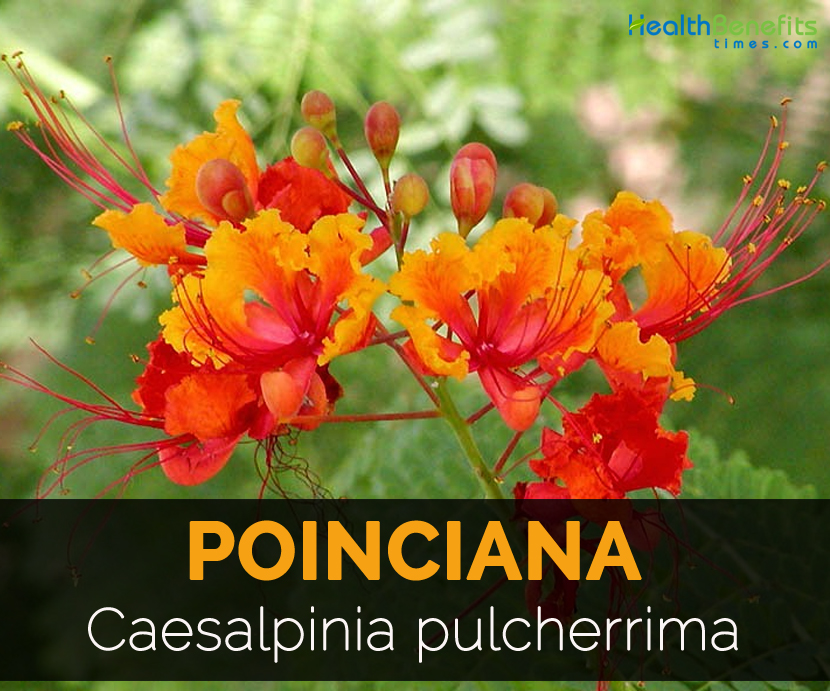| Poinciana Quick Facts | |
|---|---|
| Name: | Poinciana |
| Scientific Name: | Caesalpinia pulcherrima |
| Origin | Native of the West Indies and Mexico and Central America. |
| Colors | Brown or black |
| Shapes | Rectangular |
Plant
Caesalpinia pulcherrima is an erect, smooth much branched shrub or small tree which grows to the height of 1.5 to 6 meters high or branches unarmed or with few straight prickles. Leaves are paripinnate, alternate and 10 to 40 cm long with 5 to 9 pairs of pinnae. Inflorescence is 20 to 50 cm long in axillary and terminal raceme or panicle. Flowers are red, bisexual, orange, reddish to pink, orange, orangey to yellow and creamy or bright yellow. Sepals measure 10-15 × 5-7 mm. Petals are clawed and crisped measuring 10-25 × 6-8 mm. Pod is flat, nearly straight, compressed, smooth measuring 6 to 12 cm by 1.5 to 2 cm wide composed of 6 to 8 brown or black, rectangular seeds.
Traditional uses
- Root, flower and bark is used for treating parasitic infections and pulmonary problems.
- Leaves juice is used to cure fever and flower juice is used for curing sores and seeds help to cure chest pain, breathing difficulty.
- In Papua New Guinea, leaves provide relief from constipation.
- Pounded roots are used for convulsions in Indonesia and bark is used for treating diarrhea.
- Flower decoction is used for chronic catarrh and coughs.
- The infusion may be used as a mouthwash for gums and teeth.
- The infusion provides relief from constipation and also used to treat kidney stones.
- Root decoction is used for treatment of cholera.
- Leaves or bark infusion is used for abortion.
- An infusion prepared from leaves is used to prevent malaria and promote menstrual flow.
- Gargle with the tea to treat sores in mouth and throat.
- Use the liquid extract from flowers topically as eyewash.
Precautions
- People allergic to Poinciana should avoid it.
- Consume it in moderate amounts.
How to Eat
- Flowers, seeds and young pods are consumed.
- In Thailand, green seeds are consumed raw or cooked.
References:
http://www.plantnames.unimelb.edu.au/Sorting/Caesalpinia.html
https://www.itis.gov/servlet/SingleRpt/SingleRpt?search_topic=TSN&search_value=26511#null
https://www.cabi.org/isc/datasheet/10728
https://en.wikipedia.org/wiki/Caesalpinia_pulcherrima
http://www.tropical.theferns.info/viewtropical.php?id=Caesalpinia+pulcherrima
http://tropical.theferns.info/viewtropical.php?id=Caesalpinia+pulcherrima
http://www.fao.org/tempref/docrep/fao/010/ai387e/ai387e02.pdf
http://www.darrolshillingburg.com/GardenSite/NewsletterPDF/MG_Newsletters/MGNewsletter_Apr11.pdf
https://ajaytaobotanicalblog.wordpress.com/tag/medicinal-uses/
Comments
comments
